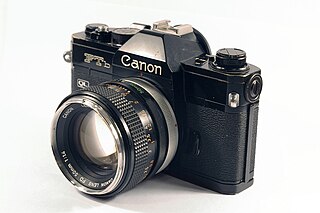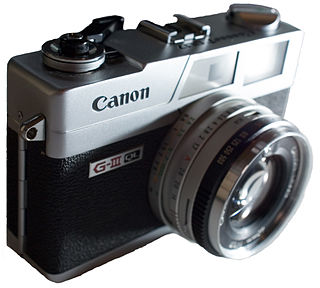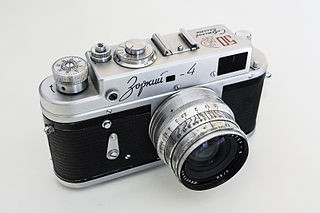
Canon Inc. is a Japanese multinational corporation headquartered in Ōta, Tokyo, specializing in optical, imaging, and industrial products, such as lenses, cameras, medical equipment, scanners, printers, and semiconductor manufacturing equipment.

The Canon EOS 10D is a discontinued 6.3-megapixel semi-professional digital SLR camera, initially announced on 27 February 2003. It replaced the EOS D60, which is also a 6.3-megapixel digital SLR camera. It was succeeded by the EOS 20D in August 2004.

The Canon EOS 20D is an 8.2-megapixel semi-professional digital single-lens reflex camera, initially announced on 19 August 2004 at a recommended retail price of US$1,499. It is the successor of the EOS 10D, and was succeeded by the EOS 30D in August 2006. It accepts EF and EF-S lenses and uses an APS-C sized image sensor.

A digital single-lens reflex camera is a digital camera that combines the optics and mechanisms of a single-lens reflex camera with a solid-state image sensor and digitally records the images from the sensor.

The Canon PowerShot G is a series of digital cameras introduced by Canon in its PowerShot line in 2000. The G series cameras are Canon's flagship compact models aimed at photography enthusiasts desiring more flexibility than a typical point-and-shoot without the bulk of a digital single-lens reflex camera.

The Canon AE-1 is a 35 mm single-lens reflex (SLR) film camera for use with interchangeable lenses. It was manufactured by Canon Camera K. K. in Japan from April 1976 to 1984. It uses an electronically controlled, electromagnet horizontal cloth focal plane shutter, with a speed range of 2 to 1/1000 second plus Bulb and flash X-sync of 1/60 second. The camera body is 87 mm tall, 141 mm wide, and 48 mm deep; it weighs 590 g. Most are black with chrome trim, but some are all black.

The Canon FTb is a 35 mm single-lens reflex camera manufactured by Canon of Japan from March 1971 replacing the Canon FT QL. It features a Canon FD lens mount, and is also compatible with Canon's earlier FL-mount lenses in stop-down metering mode. Launched alongside the top-of-the-line F-1, the FTb was the mass-market camera in the range. Its QL designation referred to the Quick Load feature introduced by the FT-QL which allowed changing film in the middle of the roll to change types of film, as well as making film loading easier.

The Canon FT QL is a 35mm single-lens reflex camera introduced by Canon Inc. in March 1966. It has a Canon FL lens mount compatible with the large range of FL series lenses. The FT can also operate the later Canon FD series lenses in stop-down mode, but the earlier R series has a different lens aperture mechanism and cannot be used, although the bayonet fitting is similar. The standard kit lenses were Canon's 50mm f/1.8 ; 50mm f/1.4 and 58mm f/1.2, the body-only option was offered later.

The Canon EOS RT is a 35mm single-lens reflex camera produced by Canon and sold from 1989 to 1992. The camera is essentially an EOS 630/EOS 600 with a pellicle mirror. Only 25,000 were manufactured at the end of the EOS 630 production run, so the EOS RT was technically "out of production" before it ever went on sale.

Tilt–shift photography is the use of camera movements that change the orientation or position of the lens with respect to the film or image sensor on cameras.

The PowerShot products is a line of consumer and prosumer grade digital cameras, launched by Canon in 1996. In 1996 a model of PowerShot was introduced to the market, The PowerShot 600. The production of The PowerShot came shortly after Canon released and subsequently discounted its SV series in 1992 and switched to digital cameras. The PowerShot line has been successful for Canon, and is one of the best-selling digital camera lines worldwide. The PowerShot's success comes its marketing to the general public as a compact and easy to use digital camera.

Digital Imaging Integrated Circuit is Canon Inc.'s name for a family of signal processing and control units for digital cameras and camcorders. DIGIC units are used as image processors by Canon in its own digital imaging products. Several generations of DIGICs exist, and are distinguished by a version number suffix.

The Canon Canonet G-III QL17 is a coupled-rangefinder, leaf-shuttered, fixed-focal-length 35 mm camera first manufactured by Canon in 1972. It features fully shutter-priority automatic exposure and fully manual shooting modes.

The EOS 1D Mark III is a professional 10.1 megapixel digital single lens reflex camera (DSLR) camera body produced by Canon. The EOS 1D Mark III was announced on February 21, 2007 and is the successor of the Canon EOS-1D Mark II N and was first released in May 2007. In late 2009, the camera was succeeded by the Canon EOS-1D Mark IV. One of the main benefits of the new Mark III, over the previous models, was the added functionality of Live view, allowing users to take pictures while looking at an LCD screen. While it had the same outdated software as the older 1D series cameras, it had a much improved button layout, which is still used today. It also had improved wireless capabilities over the Mark II. The new WFT-E2 was much smaller than the previous WFT-E1 for the Mark II. The new transmitter could now also connect via a USB port. This allowed the optional addition of a GPS unit and wired PC connectivity.

The Zorki 4 was possibly the most popular of all Zorki cameras, with 1,715,677 cameras made by the KMZ factory in Krasnogorsk, Russia. The Zorki 4 was also the first of the Zorki cameras to be exported in large numbers to the west. It is a fully manual camera, and does not have a lightmeter. An additional lightmeter may be added by the cold shoe.

A pellicle mirror is an ultra-thin, ultra-lightweight semi-transparent mirror employed in the light path of an optical instrument, splitting the light beam into two separate beams, both of reduced light intensity. Splitting the beam allows its use for multiple purposes simultaneously. The thinness of the mirror practically eliminates beam or image doubling due to a non-coincident weak second reflection from the nominally non-reflecting surface, a problem with mirror-type beam splitters. The name pellicle is a diminutive of pellis, a skin or film.

The Canon EOS 5D Mark II is a 21.0 effective megapixel full-frame CMOS digital single-lens reflex camera made by Canon, the first Canon EOS camera to have video recording capabilities. It succeeds the EOS 5D and was announced on 17 September 2008.

A mirrorless camera is a digital camera which, in contrast to DSLRs, does not use a mirror in order to ensure that the image presented to the photographer through the viewfinder is identical to that taken by the camera. They have come to replace DSLRs, which have historically dominated interchangeable lens cameras. Other terms include electronic viewfinder interchangeable lens (EVIL) cameras and compact system cameras (CSCs).

The Canon EOS-1D X is a professional digital SLR camera body by Canon Inc. It succeeded the company's previous flagship Canon EOS-1Ds Mark III and the Canon EOS-1D Mark IV. It was announced on 18 October 2011.





















